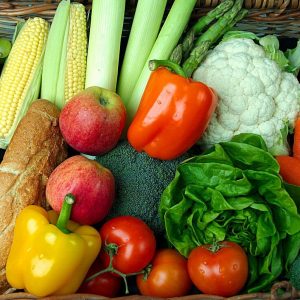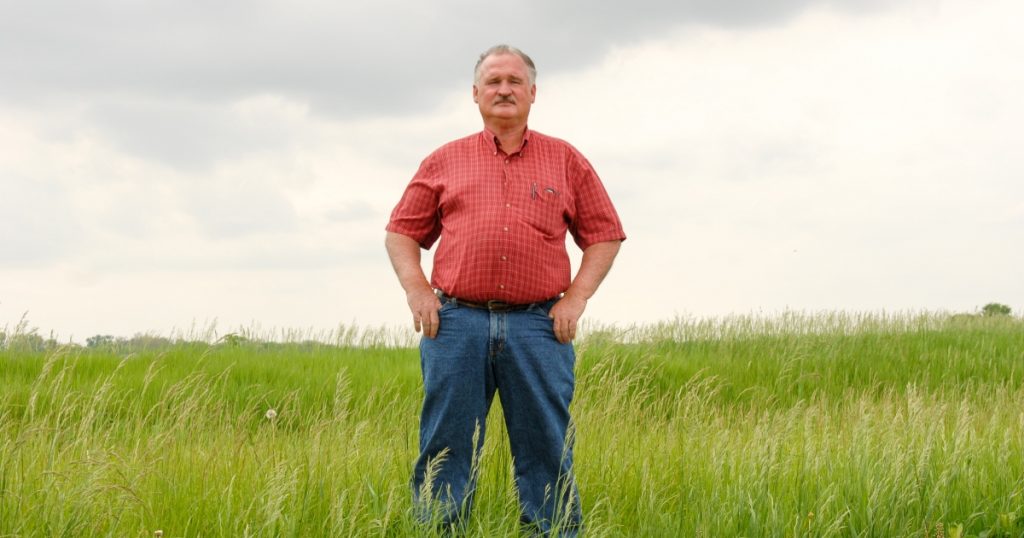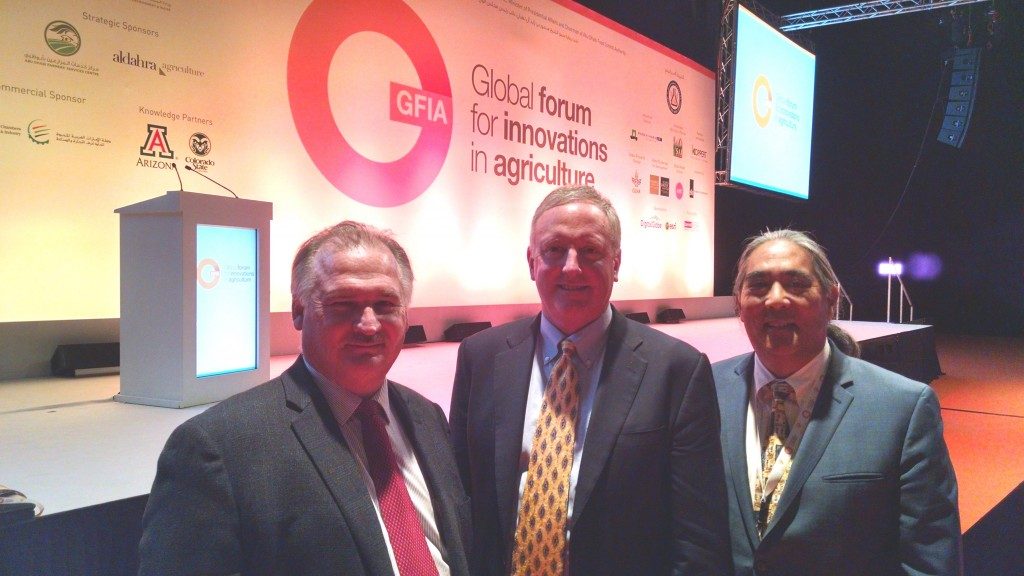Forests, Farms, and the Global Carbon Sink: It’s Happening
The Intergovernmental Panel on Climate Change (IPCC) says we need carbon sinks if we’re to meet the climate challenge, and farmers have the ability to turn forests, fields, and farms into just that. Unfortunately, they’ve been slow to embrace the global apparatuses for meeting the climate challenge, until now. Here’s how that changed, and why it matters.

9 August 2019 | Arthur “A.G.” Kawamura’s family has been growing fruits and vegetables in the US state of California for three generations, but they’ve never seen heat like this. “We’ve had two once-in-a-millennium heatwaves in the past two years,” says Kawamura. “The climate is changing, and farmers have to change with it.”
Over in Ohio, Fred Yoder agrees. His family has survived four generations of Midwestern farming – in part, he says, because they’ve always been willing to roll with the changes. “Farmers are nothing if not adaptable,” he says. “We’ve all been adapting to a changing climate, whether we admit it or not.”
But farmers aren’t just adapting to climate change; they’re also key to reversing it, as a 2017 summary of existing research and practices made clear.
Entitled “Natural Climate Solutions,” that summary identified 20 existing practices that can be scaled up to turn the world’s forests, farms, and fields into a massive sponge for absorbing greenhouse gasses and infusing them into soil, where they act as fertilizers – something the Intergovernmental Panel on Climate Change (IPCC) identified as key to preventing global average temperatures from rising 1.5 degrees Celsius (2.7 degrees Fahrenheit) above pre-industrial levels.
Yoder started advocating many of the practices 15 years ago, when served as president of the National Corn Growers Association and started experimenting with “no-till” farming.
“Some people call it ‘slot farming’,” he explains. “They call it that because you just cut a hole in the surface of the soil big enough to put the seed in, but leave the bulk of the soil intact.”
That’s “climate smart” because it both reduces greenhouse-gas emissions and fortifies crops against climate change. More specifically, it locks carbon and nitrogen in the soil, which prevents them from blending with oxygen to form carbon dioxide and nitrous oxide – two powerful greenhouse gasses. Left in the ground, they act as fertilizer, reducing the need for fertilizers derived from fossil fuels, while no-till preserves an entire web of crop-sustaining life.
“My ground is completely full of earthworms, and it has a lot of porosity, with rotted channels where the roots had been,” says Yoder. “You go where somebody has been tilling, and it’s just dead; there’s no structure.”
Kawamura promoted no-till farming and other forms of climate-smart agriculture (CSA), such as nutrient management, while serving as California’s Secretary of Agriculture under Governor Arnold Schwarzenegger, and both he and Yoder had high hopes when they joined a contingent of farmers attending the 2015 climate talks in Copenhagen, Denmark.
Boy, were they disappointed.

Agriculture and Climate Change
Farming generates between 10 and 12 percent of all anthropogenic greenhouse gasses, but that figure doesn’t include emissions from forests cleared to grow soy, oil palm, and other crops, which adds another 15 to 20 percent, depending on the year.
“We need to be talking about sustainable intensification, which is getting more production on less land and with fewer inputs,” says Yoder. “That’s the only thing that’s going to get us out of this cycle of continuously clearing land and wearing it out and then clearing some more and wearing it out again.”
That’s what he, Kawamura, and the rest of their contingent expected to find in Copenhagen.
“Everybody was talking about ending deforestation, which was great, and the whole REDD+ thing was fairly advanced,” says Kawamura, referring to a set of international agreements to save forests and reduce emissions from deforestation and degradation.
“But very few people were talking about farming,” he adds. “And when they were, most weren’t linking it to deforestation.”
What they were doing, says Yoder, was attacking agriculture.
Is There a Farmer in the Room?
Seventy-five percent of the world’s 570 million farms are family-run, and 80 percent of the farms in sub-Saharan Africa and Asia are run by smallholder farmers working 10 hectares or less. These smallholders account for just 12 percent of the world’s farmers, but they’re among those hardest-hit by climate change.
“Smallholders rightly get a lot of attention at these climate talks,” says Yoder, whose own farm covers just 1500 acres – hardly smallholder territory, but not a mega-farm, either.
“We need to support the smallholders,” he says. “But whenever commercial farming came up – and family farms are included in that – all we heard was how it was the root of all evil and needed to be completely reinvented.”
There was something else they noticed: few, if any, of the other delegates were farmers themselves.
“It’s the same thing we’d seen a few years earlier in the US,” says Yoder. “You had all these people proposing grand masterplans to change farming, but none of them had ever raised a crop in their lives.”
He and the others returned from Copenhagen determined to change that, becoming in the process part of a global effort to get farmers involved in the emerging mechanisms for ending climate change. It’s an effort they’d been engaging domestically for years, and one that began long before Copenhagen, and that was unfolding organically around the world as UN agencies like the Food and Agriculture Organization (FAO) found common ground with representative groups like the Paris-based World Farmers’ Organization (WFO) and, eventually, negotiators within the United Nations Framework Convention on Climate Change (UNFCCC).
These efforts converged in 2016, after the adoption of the Paris Climate Agreement, and they’ve been snowballing ever since. In 2017, they were formalized in a fast-track process called the Koronivia Joint Work on Agriculture, which blends separate negotiating streams that normally focus on technical and implementing procedures in isolation into one stream that includes farmers, policymakers, and NGOs.
This story is the first in a multi-part series exploring the evolution of natural climate solutions and how they can help us meet the climate challenge. Scroll down to keep reading.
Hear the Full Interview with Fred Yoder
The story continues below, but you can hear our complete interview with Fred Yoder on Episode 39 of the Bionic Planet podcast, which also features Jason Funk of Carbon 180, Tonya Rawe of CARE, and Theo de Jager of the World Farmers’ Organisation. As we roll out the articles, we’ll be posting additional podcasts featuring extended interviews with the people we’ve interviewed to pull this series together.
You can access Bionic Planet on all major podcatchers, including RadioPublic, iTunes, Stitcher, and on this device here:
Ted Turner’s Best Investment
In 1997, media entrepreneur Ted Turner made what he recently described as “the best investment I’ve ever made” – namely, a $1 billion donation to the United Nations Foundation, which is a nonprofit he founded to support the United Nations’ sustainable development objectives. Among its many projects was something called the Energy Future Coalition, which aimed to forge new thinking on energy.
The Coalition formed six working groups, focused on everything from energy efficiency to the future of coal, and they asked Maryland administrator Ernie Shea to join the working group for bioenergy and agriculture.
“They invited me to a meeting in DC, and I looked around the room and saw they didn’t have all the right people,” he says. “They were good, smart people, but they were all inside-the-Beltway types, and they didn’t have the beating heart of agriculture there.”
Shea, who was running the National Association of Conservation Districts at the time, started working his rolodex.
“Ernie reached out to everyone he knew who had any kind of sphere of influence, no matter where they were or what their sphere,” says Kawamura. “He reached out to current and former heads of farmer associations, and of state agriculture departments, and of NGOs and business groups and religious organizations; it was geographically and thematically disbursed.”
At the time, just 6 percent of US energy came from renewable sources, but a scientific survey showed they could get to 25 percent with biofuels, solar, and wind – all of which come from farms – so they set that as a goal.
“As that happened, we started to focus on the question, ‘What business are we in?’” says Shea. “Are we in the food and fiber business? Or something more? And what does that look like? Is energy part of that future? We started this conversation, and then very quickly saw this is a historic opportunity to redefine the core function of agriculture.”
To food, feed, and fiber, they added “fuel”, and in 2004 they spun the working group off into the 25x’25 Renewable Energy Alliance, which eventually formulated a clear mission statement: “By 2025, America’s farms, forests and ranches will provide 25 percent of the total energy consumed in the United States, while continuing to produce safe, abundant, and affordable food, feed, and fiber.”
The Chicago-based Farm Foundation incorporated the mission into its roundtable discussions, and environmental groups got behind it, too.
“Suddenly, we went from a dozen leaders to a couple dozen organizations, and then it just mushroomed,” says Shea. “Over a three-year period, we grew to have about a thousand organization sign on to the 25 by ’25 goal. The House and Senate both passed resolutions endorsing it, as did 35 governors.”
In 2007, they published a 35-point Action Plan that defined not just their goal, but how to achieve it.
“One of the key words in our mission statement is ‘consumed,’” says Shea. “We weren’t just talking about producing biofuels, but about consuming them, because agriculture uses a lot of energy.”
By changing their own consumption patterns, he says, farmers could easily achieve that goal – but then the backlash came.

The Biofuels Brouhaha
While 25x’25 included solar and wind, it’s primary focus was and remains biofuel, or fuels made from plant and animal matter.
Such fuels have been around since the discovery of fire, and Henry Ford used corn-based bioethanol to power his first Model T a century ago. The Kyoto Protocol, which came into effect in 2005, even treated biofuels as carbon-neutral because the combustion process re-emits carbon that the plants had mopped up from the atmosphere, while fossil fuels burp out carbon that had been stored in the earth for hundreds of thousands and even millions of years.
For these and other reasons, environmental groups embraced biofuels in the early 2000s, and they made their way into US President George W. Bush’s Renewable Fuel Standard and the federal Energy Policy Act of 2005. Farmers and processors responded by ramping up both acreage and processing capacity.
But then people started asking questions – such as how much energy it takes to grow and process biofuels, and where people will get corn for food to replace the corn now being harvested for biofuels. One study in the journal Science concluded that biofuels could end up generating twice as much greenhouse gas as petroleum does if it comes at the expense of forests.
“We kind of got whipsawed, and unfairly so,” says Yoder. “Even then, you could make biofuel from agricultural waste, and we have plenty of degraded lands that can be used to grow perennial grasses like switchgrass, which both replenish soils and can be used for biofuel.”
But biofuels were out of fashion, and farmers were left in the lurch, says environmental economist Sara Scherr, who runs a group called EcoAgriculture Partners.
“When the environmental movement woke up to realize that some of the bioenergy stuff in the United States was not the best for climate, a lot of the farmers felt betrayed, because they’d invested so much,” she says. “It’s unfair, because there’s a lot of good biofuel out there, but it all got lumped together.”
Shea believes the pushback was orchestrated in part by the fossil-fuel sector – a belief that rings true given revelations about the funding of climate-science denial.
“They ignored us at first, but then we grew up, and we started to become a threat,” he says. “The fossil fuel industry recruited surrogates to attack the premise and the goal, so we were attacked on the food front and the land conversion front. We were attacked on a water quality front and attacked on any and every front they could think of to undermine momentum and erode public confidence.”
The attacks, he adds, merely emboldened the farmers.
Building a “Do-Tank”
Meanwhile, two US politicians, Henry Waxman of California and Ed Markey of Massachusetts, were formulating the American Clean Energy and Security Act (AKA: Waxman-Markey), which would have put a cap on greenhouse-gas emissions from industry while funneling money into sustainable land-use and bioenergy, among other things.
“We were trying to figure out how agriculture could generate offsets under Waxman-Markey, and also trying to adapt to climate change, and get more research into sustainable biofuels” says Yoder.
“That got us thinking more broadly,” says Shea. “We started thinking about everything that grows up from the land, shines down on the land, blows across the land, or flows across the land – how we as farmers can positively impact the landscape, or impact water quality, or provide habitat for endangered species.”
“We were tired of all the talk, and wanted to get things going on the ground,” says Yoder. “We decided we didn’t need another think tank. We needed a ‘do tank.'”
That got the attention of Conservation International and further support from the UN foundation, and 25x’25 spawned a new group called Solutions from the Land, which aims to “harmonize competing interests in land use and identify integrated solutions that address the challenges of food and energy security, biodiversity conservation, deforestation, climate change, and sustainable economic development.”
The Nature Conservancy and Farm Foundation quickly offered their backing as well, and Yoder and Kawamura were elected co-chairs.
At the end of 2009, Shea, Yoder, and Kawamura traveled to Copenhagen for the 15th Conference of the Party (COP 15) to the UNFCCC. They came armed with policy briefs and talking points, but found history repeating itself.
“They didn’t have all the right people there, either,” says Shea.
Part Two Forests, Farms, and the Global Carbon Sink: The Genesis
Subscribe for Future Installments in this Series
This story is the first in a multi-part series exploring the evolution of natural climate solutions and how they can help us meet the climate challenge. In the coming weeks, we’ll take you back to the 1800s, when Swedish scientist Svante August Arrhenius first discovered the “hot-house” effect, then progress through the 1970s, when physicist Freeman Dyson first explored the role that forests can play in slowing climate change. We’ll see how natural climate solutions were given short shrift in the Kyoto Protocol, but came to play a central role in the Paris Climate Agreement and national climate action plans. Finally, we’ll show you how the world’s farmers began to engage the process, and how all of these elements fit into the global supply chain, and what you can do to help us meet the global climate challenge.
Please see our Reprint Guidelines for details on republishing our articles.

